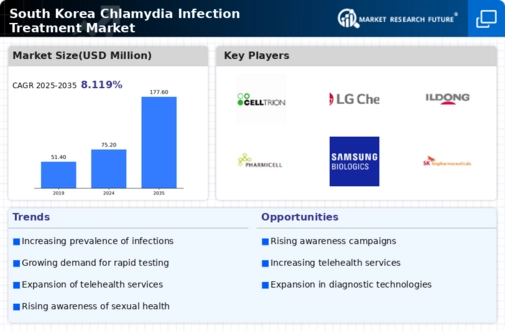Rising Incidence Rates
The chlamydia infection-treatment market in South Korea is experiencing growth due to rising incidence rates of chlamydia infections. Recent data indicates that the prevalence of chlamydia among sexually active individuals has increased, particularly among young adults aged 15-24. This demographic shift suggests a growing need for effective treatment options and screening programs. As awareness of sexually transmitted infections (STIs) rises, healthcare providers are likely to focus more on chlamydia, leading to increased demand for treatment solutions. The South Korean government has also initiated campaigns to promote STI testing, which may further drive the market. With an estimated 1.5 million cases reported annually, the urgency for effective treatment options in the chlamydia infection-treatment market is evident.
Government Health Initiatives
Government health initiatives play a crucial role in shaping the chlamydia infection-treatment market in South Korea. The Ministry of Health and Welfare has implemented various programs aimed at reducing the incidence of STIs, including chlamydia. These initiatives often include free or subsidized testing and treatment options, which can significantly increase access to care. Furthermore, educational campaigns targeting high-risk populations are designed to raise awareness about the importance of early detection and treatment. As a result, The chlamydia treatment market will benefit from increased patient engagement and participation in screening programs. The government's commitment to public health is expected to enhance the overall effectiveness of treatment strategies, thereby positively impacting market growth.
Rising Demand for Preventive Healthcare
The rising demand for preventive healthcare is a notable driver of the chlamydia infection-treatment market in South Korea. As the population becomes more health-conscious, there is a growing interest in preventive measures, including regular STI screenings. This trend is particularly evident among younger generations who are more proactive about their sexual health. The increasing availability of preventive services, such as vaccinations and routine testing, is likely to contribute to a more informed public. Consequently, the chlamydia infection-treatment market may see a surge in demand as individuals seek to prevent infections before they occur. This shift towards preventive healthcare aligns with broader public health goals and may lead to improved health outcomes across the population.
Technological Advancements in Diagnostics
Technological advancements in diagnostics are transforming the chlamydia infection-treatment market in South Korea. The introduction of rapid testing kits and point-of-care testing has made it easier for healthcare providers to diagnose chlamydia infections quickly and accurately. These innovations not only improve patient outcomes but also facilitate timely treatment, which is essential in controlling the spread of the infection. Moreover, the integration of telemedicine services allows for remote consultations and follow-ups, further enhancing access to care. As diagnostic technologies continue to evolve, the chlamydia infection-treatment market is likely to expand, driven by the demand for efficient and effective testing solutions. The potential for increased testing rates could lead to a more proactive approach to managing chlamydia infections.
Increased Focus on Sexual Health Education
An increased focus on sexual health education is influencing the chlamydia infection-treatment market in South Korea. Educational institutions and healthcare organizations are prioritizing comprehensive sexual health programs that inform individuals about STIs, including chlamydia. This emphasis on education is crucial in reducing stigma and encouraging individuals to seek testing and treatment. As awareness grows, it is anticipated that more people will engage in preventive measures, leading to earlier detection and treatment of chlamydia infections. Consequently, the chlamydia infection-treatment market may experience growth as a result of this cultural shift towards prioritizing sexual health. The long-term impact of these educational initiatives could significantly alter the landscape of STI management in South Korea.




















Leave a Comment